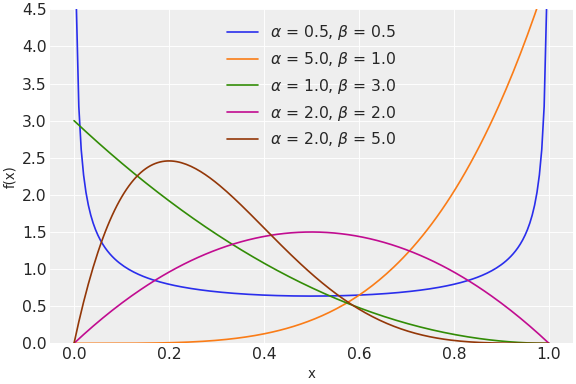pymc.Beta#
- class pymc.Beta(name, *args, rng=None, dims=None, initval=None, observed=None, total_size=None, transform=UNSET, default_transform=UNSET, **kwargs)[source]#
Beta log-likelihood.
The pdf of this distribution is
\[f(x \mid \alpha, \beta) = \frac{x^{\alpha - 1} (1 - x)^{\beta - 1}}{B(\alpha, \beta)}\]where \(B\) is the Beta function.
For more information, see https://en.wikipedia.org/wiki/Beta_distribution.
(
Source code,png,hires.png,pdf)
Support
\(x \in (0, 1)\)
Mean
\(\dfrac{\alpha}{\alpha + \beta}\)
Variance
\(\dfrac{\alpha \beta}{(\alpha+\beta)^2(\alpha+\beta+1)}\)
Beta distribution can be parameterized either in terms of alpha and beta, mean and standard deviation or mean and sample size. The link between the three parametrizations is given by
\[ \begin{align}\begin{aligned}\begin{split}\alpha &= \mu \kappa \\ \beta &= (1 - \mu) \kappa\end{split}\\\text{where } \kappa = \frac{\mu(1-\mu)}{\sigma^2} - 1\\\begin{split}\alpha &= \mu * \nu \\ \beta &= (1 - \mu) * \nu\end{split}\end{aligned}\end{align} \]- Parameters:
- alphatensor_like of
float, optional alpha> 0. If not specified, then calculated usingmuandsigma.- betatensor_like of
float, optional beta> 0. If not specified, then calculated usingmuandsigma.- mutensor_like of
float, optional Alternative mean (0 <
mu< 1).- sigmatensor_like of
float, optional Alternative standard deviation (0 <
sigma< sqrt(mu* (1 -mu))).- nutensor_like of
float, optional Alternative “sample size” of a Beta distribution (
nu> 0).
- alphatensor_like of
Notes
Beta distribution is a conjugate prior for the parameter \(p\) of the binomial distribution.
Methods
Beta.dist([alpha, beta, mu, sigma, nu])Create a tensor variable corresponding to the cls distribution.